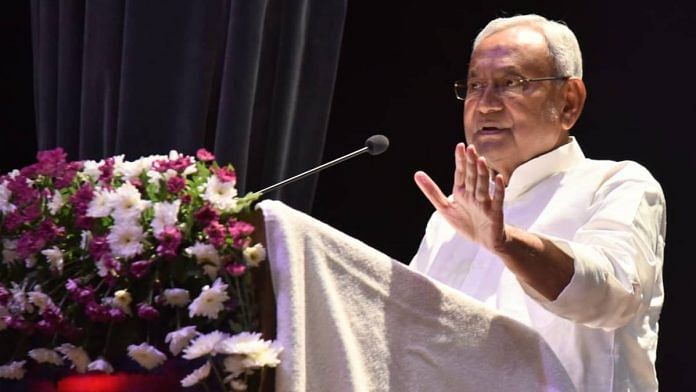New Delhi: Bihar Chief Minister Nitish Kumar Tuesday proposed that reservation in government jobs and educational institutes be raised from 50 to 65 percent in the state.
Kumar announced his plan hours after the findings of the state government’s caste-based survey were tabled in the Assembly, revealing that one-third of the families in Bihar earned less than Rs 6,000 per month.
The revised quota is apparently over and above the central government’s 10 percent reservation for individuals from economically weaker sections, a report said. This means quotas in Bihar could go up to 75 percent.
Under the fresh quota plan, candidates from Scheduled Castes (SCs) will now get 20 percent reservation, while those from Other Backward Classes (OBCs) and Extremely Backward Classes (EBCs) will get 43 percent. A reservation of two percent has been proposed for candidates from Scheduled Tribes (STs).
The caste report, tabled by Bihar Finance Minister Vijay Kumar Chaudhary earlier in the day, also found that the state’s upper castes were relatively poor, though poverty among backward classes, Dalits and tribals was expectedly higher.
Chaudhary said there were about 2.97 crore families in Bihar, of whom more than 94 lakhs (34.13 percent) were poor.
Chief Minister Nitish Kumar told lawmakers that it was wrong to say which caste got more economic benefits and which got less when a caste census was never carried out in Independent India.
“When we told the central government that we want a caste-based census, we were told states could go ahead,” Kumar said of the ruling BJP’s reluctance to conduct such a survey nationwide. Incidentally, the last pan India caste survey was held in 1931.
https://twitter.com/PTI_News/
Bihar’s caste survey, carried out earlier this year, also detailed the economic status of various groups.
The data showed that 29.61 percent survived on a monthly income of Rs 10,000 or less, while nearly 28 percent lived on a monthly income between Rs 10,000 and Rs 50,000, and less than four percent earned over Rs 50,000 per month.
It also found that 50 lakh Biharis have emigrated out of the state in search of better employment or education opportunities, of which 2.17 lakh are working abroad and 27,000 are studying in foreign universities.
A preliminary report of the survey was tabled in the Assembly on 2 October, which found that OBCs and EBCs constituted more than 60 percent of the state’s total population, while upper castes accounted for nearly 10 percent.
The most well-off Hindu upper caste was the numerically minuscule Kayasthas – only 13.83 percent of families from this largely urbanised community were found to be poor, according to the survey.



